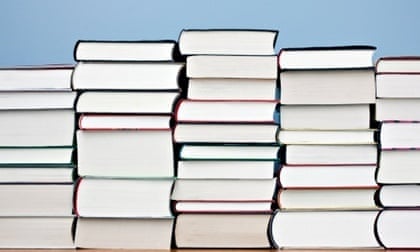When I was a young woman, I drew a sort of perverse pride from my willingness to skip a meal or two in order to afford books. Soon enough, with the ubiquity of credit card touts on campus, I could buy both books and meals. I justified my increasing debt as necessary for my education, and joked with friends that while others spent their money on cars and expensive clothes, anything of value that I owned was on my bookcases.
I realise now that my “jokes” were, in fact, humblebrags. I did love books, always had, but I also took a certain arrogant pleasure from owning so many. It was also when my first “To Be Read” (TBR) pile started – all those volumes I had bought with the intention of reading them. And while years later, adult economics has forced me to stop shopping every time I step into a bookstore, my work as a reviewer now means that an average of five new titles arrive on my doorstep each week. My TBR pile is ceiling-high, and while I’m not going into debt, the visceral pleasure that I get from being surrounded by books remains the same.
In the 19th century, book collecting became common among gentlemen, mostly in Britain, and grew into an obsession that one of its participants called “bibliomania”. Thomas Frognall Dibdin, an English cleric and bibliographer, wrote Bibliomania, or Book Madness: A Bibliographical Romance, which was a gentle satire of those he saw as afflicted with this “neurosis”. Dibdin medicalised the condition, going so far as to provide a list of symptoms manifested in the particular types of books that they obsessively sought: “First editions, true editions, black letter-printed books, large paper copies; uncut books with edges that are not sheared by binder’s tools; illustrated copies; unique copies with morocco binding or silk lining; and copies printed on vellum.”

But Dibdin himself was obsessed with the physical aspects of books, and in his descriptions paid an intense attention to the details of their bindings and printings (rather than the content) that betrayed his own love. In a letter published in an 1815 journal, he beseeched subscribers to bulk up their subscriptions to help complete a set of volumes called The Bibliographical Decameron – more beautiful than they could imagine. “I should be loth to promise what is not likely to be performed, or to incur the censure of vanity or presumption in asserting that the materials already collected, in this department of the work, are more numerous, more beautiful, and more faithful, than any which, to my knowledge, have come under the eye of the publick.”
While Dibdin was having new materials created to satisfy the hunger of those who sought books, the auctions for existing items brought staggering prices. The bloody end of so many French nobles in the revolution saw an influx of collectibles arrive on the market as private libraries were posthumously emptied. In 1812, the auction that released the library of John Ker, third duke of Roxburghe, represented a watershed moment, according to Michael Robinson, who teaches at the University of Massachusetts-Dartmouth. In his forthcoming book Ornamental Gentlemen, Robinson says interest in the Roxburghe auction was stirred by advertising, as well as the wartime shortage of books. Many wealthy Englishmen – and a representative of Napoleon – showed up for the auction, which lasted 42 days, and included a tremendous selection of incunabula (books printed prior to 1500). An edition of Boccaccio went for £2,260 (around $190,000 in today’s US dollars), the highest single price paid for a book up to that point. Dibdin himself witnessed the auction, recalling the event as having been full of “courage, slaughter, devastation, and phrensy”.
Even Thomas De Quincey, author of Confessions of an English Opium Eater, described bibliomaniacs as irrational
The obsessive pursuit of books did not take place apart from the wider culture, however. Recent studies have revealed tensions between a nascent republican Britain and these bibliomaniacs. Even Thomas De Quincey, author of the addiction memoir Confessions of an English Opium Eater, described the literary addicts he had observed at the Roxburghe auction as irrational, and governed by “caprice” and “feelings” rather than reason. De Quincey uses the term pretium affectionus – “fancy price” – to describe how prices were decided, transforming the book collector into a dandy ruled by his emotions.
While it may be too early to speak of a “gay” subculture, Robinson writes of the “uncanny queerness of the stereotypical representation of 19th-century bibliophiles”. Men who collected books were often portrayed as effeminate. In 1834, the British literary magazine the Athenaeum published an anonymous attack implying that one of the prominent members of Dibdin’s club was homosexual.
Dibdin’s language, which has been noted for its sensuality, is full of double entendres and descriptions of book collecting in sexualised language; from his Bibliographical Decameron, some characteristic dialogue:
“Can you indulge us with a sip of this cream?”
“Fortunately it is in my power to gratify you with a pretty good taste of it.”
As Robinson told me: “Dibdin’s mock-heroic discourse about books and collectors contains language that is hard to read as anything other than sexual innuendo. The sexiness of this stuff is quite surprising, actually – to the point where it can’t really be called innuendo. These facets of the subculture suggest the possibility that men who might today identify as gay or queer were drawn to collecting.”
One of the concerns in the early 19th century regarding book collecting was the fear that by hoarding books, buyers were denying their fellow countrymen their patrimony. The image of the rich dilettante was one of the conspicuous consumer of books that would never be read – the old TBR pile – therefore keeping books out of an intellectual commons. The collector was often portrayed as having a kind of antisocial disease that kept him from contributing to the greater good by sharing his printed riches. But the origin for many literary anthologies lay in the libraries of these private collectors – who were, in their own way, establishing a national literary inheritance.
The Strahov Library in Prague. Its collection dates back to the 12th century, when the monastery was founded. Many books disappeared when Swedish troops invaded Prague in 1648 and took books back with them. Photograph: Alamy Stock PhotoAs colonial-era explorers would help themselves to other countries’ archaeological treasures or artworks, book collectors were arguably guilty of similar cultural theft. But a search of the academic literature of bibliomania failed to turn up such charges. I did, on the other hand, find a curious book review from 1855 that discussed the “Arab domination” of Spain prior to the Reconquista. In the review, a critique of Muslim bibliomania is offered: while lauding the Moors’ preservation of western culture during the period pejoratively known as the dark ages, “few of their works, however, are of value to the modern scholar”. In full Orientalist language, the book collectors of the Islamic world are dismissed with the same terms used by earlier critics of British collectors: “We cannot sympathise with their ecstatic vagaries of passion, or discover much merit in their over-sensuous images and descriptions, and their verbose and stilted euphemism.” It was seemingly OK for the Arabs to have saved Aristotle and the mathematicians – but their choice to preserve books containing passionate language made Victorians uncomfortable.
By the turn of the century, as evidenced by a 1906 Metropolitan Museum of Art article, book collecting was no longer disparaged. Skill was required to separate the gold from the dross; book collecting was now a “whole science” and readers were told that they, too, could score a find, as long as they possessed “keen judgment, faultless taste, inexhaustible patience – and contempt for ridicule”. As the author points out, it takes special knowledge to know that Franklin Evans’s The Story of an Inebriate – a book many would throw away – was actually Walt Whitman’s “first published work, and that it is rare and valuable”. Bibliomania was now a bragging right.
I chose my graduate school based on its library collection: Cornell, in Ithaca, New York, was cofounded by historian and bibliomaniac Andrew Dickson White, who spent his life travelling the world and collecting books, and donated more than 34,000 rare tomes to establish Cornell’s library. In that, his bibliomania was useful to a common cause, despite the fears of previous critics: to this day, scholars journey to Ithaca to use what would have once been privately admired on White’s shelves. The first time I sat in that library, holding a book published before 1500, I felt something akin to the way I have felt next to oceans: tiny, and in right proportion to the world. Handling books from centuries before is a poignant reminder that, not only have people loved books for as long as they have existed, they will continue to do so long into the future. Perhaps today, bibliomania does not feel like an irrational behaviour, as books have become less venerated and libraries rarer. Rather, as it was for others before us, it is a careful act of preservation for those who come after.















Pentru a putea adăuga comentarii trebuie să fii membru al altmarius !
Alătură-te reţelei altmarius